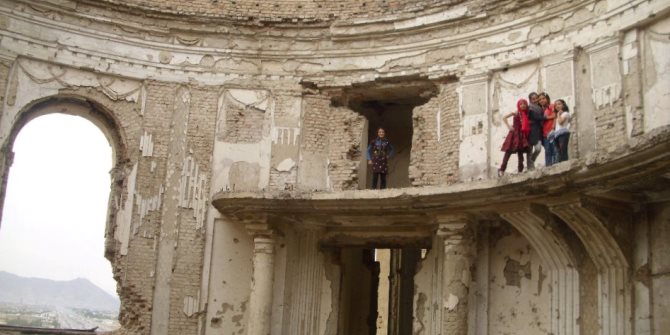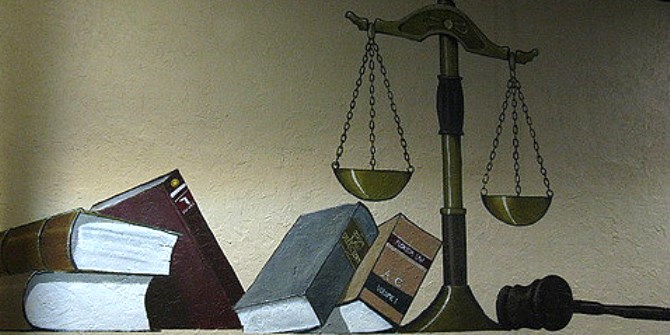 Afghanistan is a multi-ethnic country and the nature of this diversity is important in understanding the 2014 presidential electoral process and the central role of ethnicity within it. Drawing on research conducted for her Master’s thesis, Rabia Nasimi writes that the concept of ethnic identification is a social construct with both fixed and fluid components, and discusses how ethnicity manifested itself in the eyes of political campaigners working for the two main candidates in 2014.
Afghanistan is a multi-ethnic country and the nature of this diversity is important in understanding the 2014 presidential electoral process and the central role of ethnicity within it. Drawing on research conducted for her Master’s thesis, Rabia Nasimi writes that the concept of ethnic identification is a social construct with both fixed and fluid components, and discusses how ethnicity manifested itself in the eyes of political campaigners working for the two main candidates in 2014.
Afghanistan is an ethnically heterogeneous country consisting of many different ethnic groups, four of which are said to represent the majority. However, the absence of an accurate national census means an ethnic group’s claim of being the largest remains a political dilemma, rather than a factual reality. Estimates of the four major ethnic groups indicate the population is 38% Pashtun, 25% Tajik, 19% Hazara and 10% Turkic respectively. However, the exact proportions of each ethnicity continue to be questioned, as it is politically sensitive and considered relevant to political discussions in Afghanistan. Of the two candidates in the second round of the elections, Ashraf Ghani was Pashtun and Abdullah Abdullah came from a Tajik background (although some claim that he is mixed Tajik and Pashtun).
The 2014 presidential election in Afghanistan was the third presidential poll since the fall of the Taliban in 2001 and the first time power in Afghanistan had been democratically transferred. It therefore marked a major milestone for democratisation. The first round of elections process took place on 5 April 2014. When the Independent Election Commission (IEC) announced the results on 15 May, no candidate had garnered a majority of the votes or crossed the necessary 50% threshold and a runoff between the two most popular candidates, Ghani and Abdullah, who had won 31% and 45% of votes respectively, was therefore called for 14 June. The second round of voting was fraught with strife and tension but eventually returned a result of 56% for Ghani and 44% Abdullah. The IEC declared Ghani the winner of the election but Abdullah threatened to reject the results, arguing that industrial-scale fraud had taken place. To lessen the tension, the candidates eventually agreed to a power sharing agreement which led to the creation of the National Unity Government (NUG) led by Ghani but with an extra constitutional position, entitled ‘Chief Executive Officer’, created for Abdullah.

My study set to provide unique insight into understanding a political campaigner’s point of view by examining their particular reasoning for supporting a chosen candidate and the explanation for the ethnic dynamics adopted in the 2014 electoral campaigning process. In order to do this, I interviewed 12 political campaigners, six from each of the two major electoral campaigns. Four key themes highlighting the salience of ethnic identities emerged from the findings: electoral campaigning, formation of election teams, voting behaviour and debates around ethnicity in the national unity government.
Electoral campaigning
An individual believing in ethnicity as a choice, rather than assigned at birth, provides some insight into the complexity of ethnic identification, even amongst electoral campaigners who have an educative position in the elections. The study therefore confirms the complexity of defining ethnicity either as a biological concept or a social construct. The campaigners’ experiences self-identification with their own ethnicity supports notion that ethnicity is a social construct that is not fixed but fluid: from the selection of Ghani campaigners, three identified as ‘Pashtun’, one as ‘Afghan’, one as ‘Hazara’ and one stated that he is ‘ethnically Tajik but identifies as Pashtun’. Among those interviewed from Abdullah’s campaign, three campaigners identified themselves as ‘Tajik’, one as ‘Uzbek’, one as ‘Pashtun’ and one identified with ‘all ethnicities’.
Campaigners on both sides therefore had individuals who either did not strongly identify with one or any particular ethnic group. Nevertheless, the majority of campaigners identified with one of the two largest ethnic groups in Afghanistan. This ability to identify with one particular ethnic group suggests the majority still support the primordial perspective which holds that ethnic identification is a belief in a shared common ancestry.
Formation of election teams
“Both teams tried to include people from different ethnicities in their election campaign and they succeeded, as their teams were comprised of different people from different ethnicities” – Ghani Campaigner
The campaigners reflected on the need for ethnic diversity in the campaign, not only in the selection of vice presidential running mates but also the make-up of the campaigners themselves. The campaigners addressed the need for ethnic diversity in voter mobilisation, with discussions of inclusivity and unanimity included as part of the rationale used to address why the presidential candidate needed to reach across ethnic boundaries. It seemed that both teams utilised ethnicity equally throughout the campaign.
Voting behaviour
“Most of the voters still vote/voted based on ethnicity, while at least half of educated youth might have voted based on political campaign”. – Abdullah Campaigner
The campaigners believed that most people will mostly vote for someone who shares a common culture and ethnic identity instead of looking at a candidate’s experience and considering their merits. This perspective might help to understand why the presidential candidates’ messages added to the ethnic rhetoric rather than downplaying ethnic divisions. The research provided several alternative explanations as to why Afghans continue to vote along ethnic lines. Campaigners’ perception of voting and voting behaviour seem to suggest that overall most people will vote for someone who shares a common culture and ethnic identity. A lack of understanding of the democratic electoral system is a possible reason for voters choosing to vote along ethnic lines.
National unity government
“Division between two teams is never a good prescription for Afghanistan” – Ghani Campaigner
Some campaigners argued that although the ideal of a national unified government is to be ethnically inclusive, it could be argued that there is a risk that its failure to achieve this goal may simply strengthen the ethnic fissures further, as opposing sides may attempt to exercise significant influence over ministries and institutions. Power sharing has meant that Abdullah was promised that his team would get half the important ministries and therefore did not lose out altogether. Others argue that because the national unity government was suggested by the U.S., it could result on continuing dependence on the U.S. for basic functions of government such as diplomatic engagement, which may help keep the government stable and deter any attempts of either party to grab power.
What are the theoretical and policy implications of the study?
Firstly, this study shows that regardless of whether ethnicity is social construct or an innate category, it is worth studying, as it is powerful enough to mobilise people. Second, it suggests that a lack of transparent figures in relation to ethnicity continues to be a source of conflict. Everyone has their own subjective figures of the population, and this indeed exacerbates tension, as each stakeholder group contends that they are more powerful. Thirdly, it recommends that when studying elections, thought should be given to whether the country is a new democracy or a mature democracy, as that will ultimately reflect on their approaches. This meant that during the study, care was given when comparing Afghanistan to democratic theory and or to mature democracies as it is still in a transitional period.
This post gives the views of the author, and not the position of the South Asia @ LSE blog, nor of the London School of Economics. Please read our comments policy before posting.
About the Author
 Rabia Nasimi is an MSc Candidate in Sociology (Research) at LSE. Her research interests include identity, ethnicity and nationalism, particularly in relation to Afghanistan. You can read more about her identity story here and can also follow her on Twitter at @rabianasimi.
Rabia Nasimi is an MSc Candidate in Sociology (Research) at LSE. Her research interests include identity, ethnicity and nationalism, particularly in relation to Afghanistan. You can read more about her identity story here and can also follow her on Twitter at @rabianasimi.






